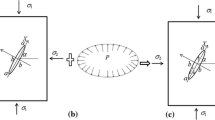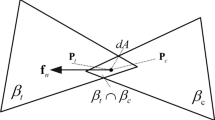Abstract
Large cracks are important seepage channels inside fractured-vuggy reservoirs. Therefore, in this thesis, the calculation method of fully coupled modeling of the fractured saturated porous medium based on the extended finite element method (XFEM) is established to study the expanding regularity of cracks in fractured-vuggy reservoirs. Fully coupled governing equations are developed for hydro-mechanical analysis of deforming porous medium with fractures based on the stress balance equation, the seepage continuity equation and the effective stress principle. The final nonlinear fully coupled equations reflect not only the coupling effect of the physical quantity within the porous medium but also the coupling between the medium and the fracture. During the spatial dispersion of coupled equations based on XFEM, two kinds of additional displacement functions are introduced in the displacement model of the fracture area to reflect the strong discontinuity of the fracture surface. The pore pressure enhancement function is also applied to represent the weak discontinuous features of the normal pore pressure. The validity and efficiency of this model and calculation are verified through three calculating examples. The following crack propagation laws are obtained: (1) The larger the water flow rate is, the longer the crack propagation length is, and the larger the propagation width is (2) The greater the crack angle and the crack length, the easier it is to expand the crack. Besides, compared with dip angle, the crack length has a more sensitive influence to the crack propagation. (3) When multiple cracks exist, the larger the fracture spacing is, the easier the crack will expand.














Similar content being viewed by others
References
Abdul RS, Sheik SR, Nam HT, Thanh T (2011) Numerical simulation of fluid–rock coupling heat transfer in naturally fractured geothermal system. Appl Therm Eng 31:1600–1606
Alexandre L (2013) Numerical modeling of steady-state flow of a non-Newtonian power-law fluid in a rough-walled fracture. Comput Geotech 50:101–109
Benoit C, Sylvie G (2012) Numerical modeling of hydraulic fracture problem in permeable medium using cohesive zone model. Eng Fract Mech 79:312–328
Biot MA (1941) General theory of three dimensional consolidation. J Appl Phys 12:155–164
Birk C, Behnke R (2012) A modified scaled boundary finite element method for three-dimensional dynamic soil–structure interaction in layered soil. Int J Numer Methods Eng 89:371–402
Bitao L, Jennifer L, Wu YS (2012) Non-Darcy porous-media flow according to the Barree and Conway model: laboratory and numerical-modeling studies. SPE J 17:70–79
Boit MA, Willis PG (1957) The elastic coefficients of the theory consolidation. J Appl Mech 24:594–601
Chen ZR (2012) Finite element modelling of viscosity-dominated hydraulic fractures. J Pet Sci Eng 88:136–144
Cuo JC, Zhao X, Zhu HY, Zhang XD, Pan R (2015) Numerical simulation of interaction of hydraulic fracture and natural fracture based on the cohesive zone finite element method. J Nat Gas Sci Eng 25:180–188
Elizaveta G, Anthony P (2013) Implicit level set schemes for modeling hydraulic fractures using the XFEM. Comput Methods Appl Mech Eng 266:125–143
Erasmo V, Francesco T, Nicholas F (2013) Generalized differential quadrature finite element method for cracked composite structures of arbitrary shape. Compos Struct 106:815–834
Farzin H, Ali M (2014) A new three dimensional approach to numerically model hydraulic fracturing process. J Pet Sci Eng 124:451–467
Giner E, Sukumar N, Tarancon JE, Fuenmayor FJ (2008) An abaqus implementation of the extended finite element method. Eng Fract Mech 76:347
Gupta P, Duarte CA (2014) Simulation of non-planar three-dimensional hydraulic fracture propagation. Int J Numer Anal Methods Geomech 13:1397
Huang ZQ, Yao J, Wang YY (2013) An efficient numerical model for immiscible two-phase flow in fractured karst reservoirs. Commun Comput Phys 13:540–558
Kang YZ (2008) Characteristics and distribution laws of paleokarst hydrocarbon reservoirs in palaeozoic carbonate formations in china. Natl Gas Ind 28:1–12
Li S, Kang YL, Li DQ, Lian ZH (2014) Experimental and numerical investigation of multiscale fracture deformation in fractured-vuggy carbonate reservoirs. Arab J Sci Eng 39:4241–4249
Magnus W (2012) Finite element modeling of hydraulic fracturing on a reservoir scale in 2D. J Pet Sci Eng 77:274–285
Mohammadnejad T, Khoei AR (2013a) Hydro-mechanical modeling of cohesive crack propagation in multiphase porous media using the extended finite element method. Int J Numer Anal Methods Geomech 37:1247–1279
Mohammadnejad T, Khoei AR (2013b) An extended finite element method for hydraulic fracture propagation in deformable porous media with the cohesive crack model. Finite Elements Anal Des 73:77–95
Morland LW (1972) Asimple constitutive theory for fluid saturated porous solids. J Geophys Res 77:890–900
Motamedi D, Mohammadi S (2010) Dynamic crack propagation analysis of orthotropic media by the extended finite element method. Int J Fract 161:21–39
Mousavi SE, Sukumar NP (2010) Generalized Gaussian quadrature rules for discontinuities and crack singularities in the extended finite element method. Comput Methods Appl Mech Eng 199:3237–3249
Olaga K, Wen XW, Gu HR, Wu RT (2013) Numerical modeling of hydraulic fractures interaction in complex naturally fractured formations. Rock Mech Rock Eng 46:555–568
Sarris E, Papanastasious P (2012) Modeling of hydraulic fracturing in a poroelastic cohesive formation. Int J Geomech 12:160–167
Shi JX, David C, Jim L, Sukumar N, Ted B (2010) Abaqus implementation of extended finite element method using a level set representation for three-dimensional fatigue crack growth and life predictions. Eng Fract Mech 77:2840–2863
Stelzer R, Hofstetter G (2005) Adaptive finite element analysis of multi-phase problems in geotechnics. Comput Geotech 32:458–481
Terzaghi K (1943) Theoretical soil mechanics. Wiley, New York
Wang SY, Sloan SW, Fityus SG, Griffiths DV, Tang CA (2013) Numerical modeling of pore pressure influence on fracture evolution in brittle heterogeneous rocks. Rock Mech Rock Eng 46:1165–1182
Wang T, Zhou WB, Chen JH, Xiao X, Li Y, Zhao XY (2014) Simulation of hydraulic fracturing using particle flow method and application in a coal mine. Int J Coal Geol 121:1–13
Wen XW (2015) Modeling of complex hydraulic fractures in naturally fractured formation. J Unconv Oil Gas Res Mech Min 9:114–135
Wu YS, Forsyth P (2001) On the selection of primary variables in numerical formulation for modeling multiphase flow in porous media. J Contam Hydrol 48:277–304
Zhang QY, Duan K, Jiao YY, Xiang W (2017a) Physical model test and numerical simulation for the stability analysis of deep gas storage cavern group located in bedded rock salt formation. Int J Rock Mech Min 94:43–54
Zhang QY, Zhang XT, Wang ZC, Xiang W, Xue JH (2017b) Failure mechanism and numerical simulation of zonal disintegration around a deep tunnel under high stress. Int J Rock Mech Min 93:344–355
Zhao WZ, Shen AJ, Hu SY, Zhang BM, Pan WQ, Zhou JG, Wang ZC (2012) Geological conditions and distributional features of large-scale carbonate reservoirs onshore China. Pet Explor Dev 39:1–14
Acknowledgements
The research described in this paper was financially supported by the National major research and development program (No. 2016YFC0401804-03), the preliminary research project of the underground experimental project for the geological disposal of high-level radioactive waste (No. YK-KY-J-2015-25), the National Natural Science Foundation of China (No. 51279093) and Major national science and technology projects (No. 2011ZX05014).
Author information
Authors and Affiliations
Corresponding author
Additional information
Publisher's Note
Springer Nature remains neutral with regard to jurisdictional claims in published maps and institutional affiliations.
Rights and permissions
About this article
Cite this article
Zhang, Q., Wang, C. & Xiang, W. A Seepage-Stress Coupling Model in Fractured Porous Media Based on XFEM. Geotech Geol Eng 37, 4057–4073 (2019). https://doi.org/10.1007/s10706-019-00893-2
Received:
Accepted:
Published:
Issue Date:
DOI: https://doi.org/10.1007/s10706-019-00893-2




